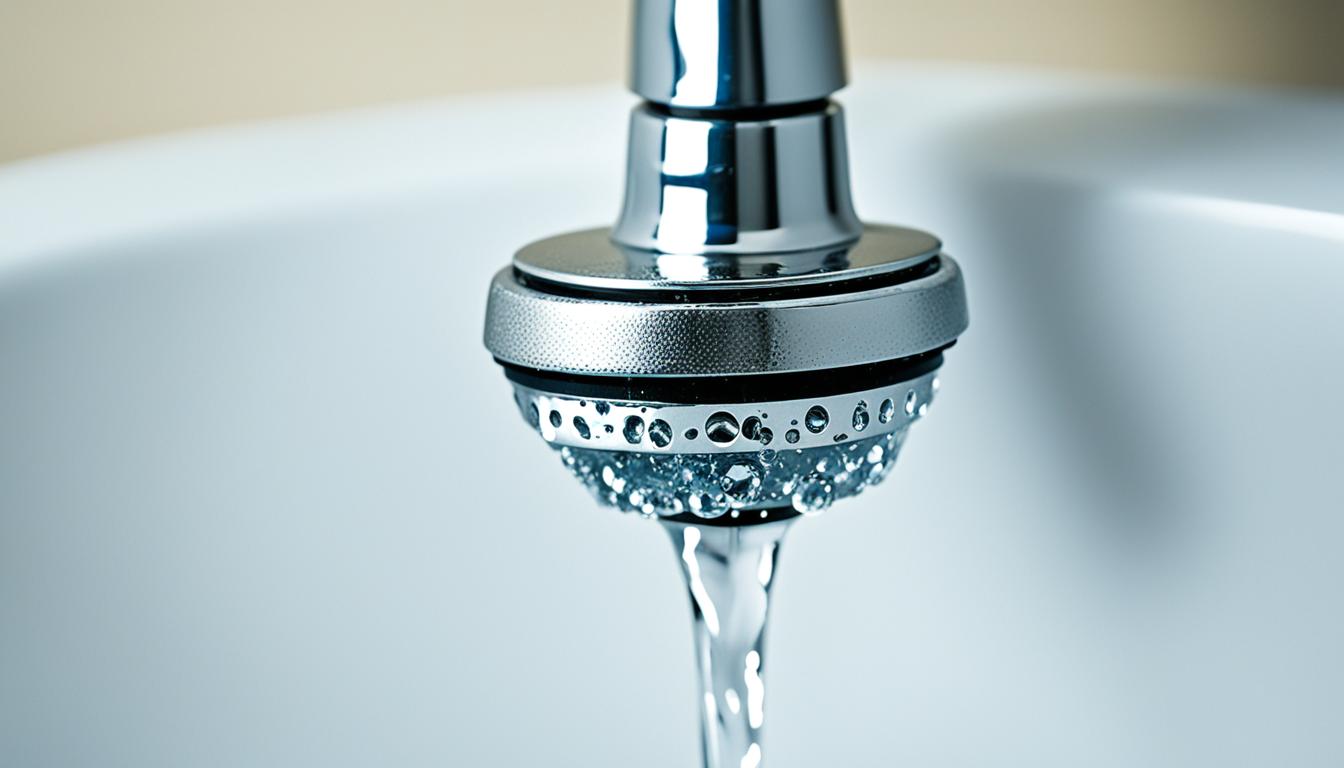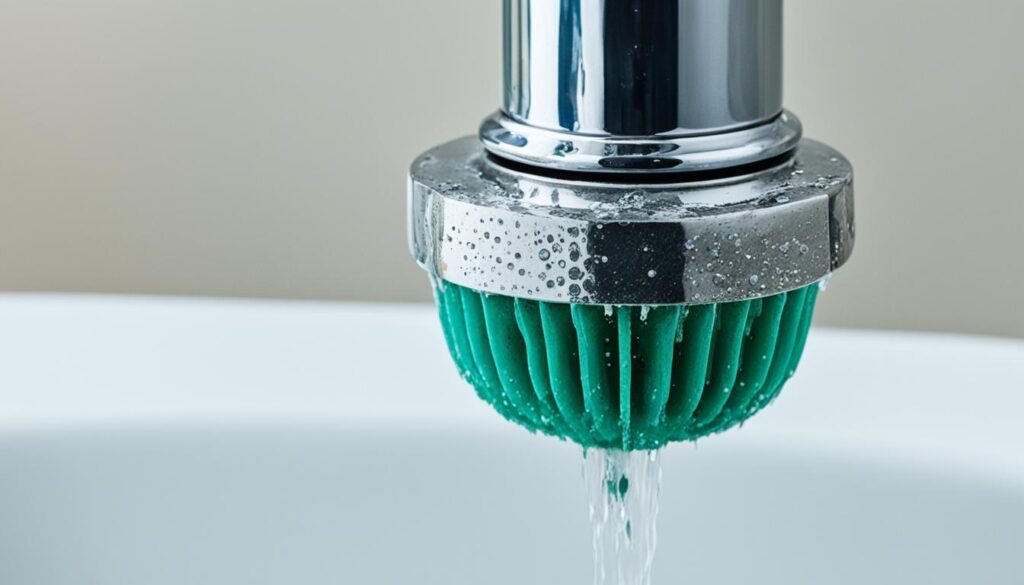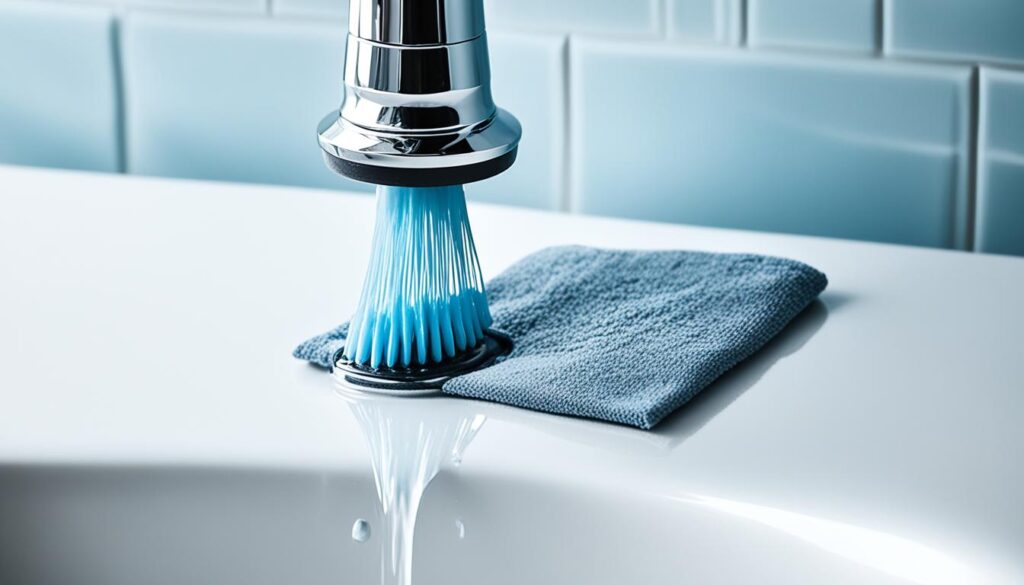Cleaning the sink faucet head keeps it working well and looking good. Hard water and grime build-up can slow the water flow and create bad smells. We provide clear steps to clean your sink faucet head properly, making it work and look like new.
Key Takeaways:
- Regular cleaning of your sink faucet head is important to maintain optimal water flow and hygiene.
- Vinegar is a great tool for cleaning faucet heads, but it’s not recommended for all faucet finishes such as black, bronze, or gold coatings due to its acidity.
- CLR (calcium, lime, and rust) cleaner is safe for some surfaces, but it’s crucial to read the label and follow the instructions to avoid damage or personal injury.
- A 50/50 solution of CLR and water is recommended for cleaning faucet heads and shower heads.
- After soaking the faucet head, it’s important to scrub it to remove any residue and remaining grime.
- Proper ventilation is crucial when using vinegar or CLR for cleaning purposes.
- In case of feeling ill after using household cleaners, call 911 or the Poison Control Center at 1-800-222-1222.
- Consider hiring a local house cleaning expert who may offer faucet head cleaning as an additional service, possibly costing under $10.
- Cleaning a faucet head can be done with items commonly found at home or with store-bought cleaning products.
- Soaking the aerator in white vinegar or a 50/50 mix of vinegar and baking soda for 30 minutes is recommended for effective cleaning.
- For heavy buildup, commercially available calcium, lime, and rust removers can be used, following the product directions to avoid damaging the faucet fixture.
The Importance of Cleaning Your Faucet Head
Cleaning your faucet head often is key for your fixtures to work well. Over time, dirt and mineral deposits build up. These can block water flow and even cause bad smells. By making faucet head cleaning a regular task, you prevent these issues. This helps ensure your fixtures last longer too.
Keeping the faucet head clean stops dirt and hard water deposits from piling up. These include minerals and dirt which can block the water. Also, daily use can add limescale and soap scum. These cause clogs. A clean head means better water pressure and flow.
Regular cleaning also fights harmful bacteria. With time, faucet heads can grow mold and mildew. This poses health risks. By cleaning it often, you get rid of these dangers. This protects your family’s health.
The look of your faucet head matters too. A shiny, clean head makes your kitchen or bathroom look better. It keeps your faucet attractive. This makes a beautiful feature in your room.
Choosing the right cleaner for your faucet head is crucial. Vinegar is great for most heads. It’s safe and removes minerals well. But, it can harm some materials, like chrome. Always check what your faucet is made of before cleaning. Also, know how long you can leave vinegar on it. For chrome, it’s 2 hours max. For other materials, not more than 30 minutes is safe.
If there are tough stains, powdered citric acid can help. But, this can irritate your eyes. Be safe by wearing protective clothes and following the cleaning directions.
There are many ways to clean your faucet head. You can soak it in vinegar and water. Or, make a paste with baking soda. Using CLR is another option. We’ll talk more about the best ways to clean in the next parts of this guide.
Knowing how and why to clean your faucet head is important. It makes the water flow better and stops bacteria. Plus, your fixtures will last longer. This also makes your space look nicer. Keep up good cleaning habits for a great faucet head for years.
Methods for Cleaning Sink Faucet Head
Limescale, soap scum, and food debris can build up on faucet heads from everyday use. This can lower water pressure and flow. That’s why it’s important to clean your sink faucet head often (The Cleaning Authority’s Brand President, Katie Dills).
Vinegar is a great option for cleaning faucet heads (The Cleaning Authority). But be careful, vinegar can harm surfaces like natural stone or coated faucets. It’s not good for black, bronze, or gold finishes either because it’s too acidic (The Cleaning Authority).
Cleaning with vinegar is easy and effective. Mix equal parts white vinegar and water in a plastic bag. Put the faucet head in the solution and seal the bag. Let it soak for 30 minutes (The Cleaning Authority). Then, use a toothbrush to scrub it clean.
Another good way is to make a paste of baking soda and water. Put the paste on the faucet head and wait 30 minutes. Next, use a toothbrush to scrub it. Rinse it well with water to get rid of any leftover paste (The Cleaning Authority).
A product like CLR cleaner can help if the buildup is heavy. But, be sure to read and follow the instructions carefully (The Cleaning Authority).
Baking soda paste or hydrogen peroxide can also work. They’re good for getting rid of dirt and mineral buildup (The Cleaning Authority).
Be safe when cleaning faucet heads. Wear gloves to protect your skin from vinegar. And make sure the area is well-ventilated (The Cleaning Authority).
It’s vital to clean your sink faucet head regularly to stop dirt and water deposits. While vinegar is good for removing buildup, be careful with your faucet’s finish. For example, chrome shouldn’t be in vinegar for over two hours. Materials like nickel, gold, or brass should soak for no more than 30 minutes (The Cleaning Authority).
To summarize, there are many ways to clean sink faucet heads like using vinegar or baking soda. Each method is effective at getting rid of mineral buildup and germs. Pick the best way depending on your faucet’s material to keep it clean and working. Regular cleaning and care are key (The Cleaning Authority).
Cleaning with Vinegar
Vinegar is a great cleaning agent for removing mineral buildup and bacteria from your faucet head. It’s an easy and cheap way to get your faucet shining.
You will need a few simple items to start. Grab a plastic bag, white vinegar, tap water, a rubber band, and a toothbrush.
Follow these steps to clean your faucet head with vinegar:
- Mix equal parts white vinegar and tap water in a plastic bag. Vinegar breaks down mineral buildup, and water lessens its acidity to protect the faucet.
- Place the faucet head in the bag so it’s fully submerged. Secure the bag with a rubber band.
- Let it soak for 30 minutes. This gives the vinegar time to dissolve minerals and kill bacteria.
- After soaking, remove the bag and scrub the faucet head with a toothbrush gently.
- Rinse the faucet head well to wash away any leftover vinegar. Then, dry it with a clean cloth.
Remember, don’t let vinegar sit on certain faucet finishes for too long. Chrome can’t have vinegar on it for over two hours. Nickel, gold, or brass can’t soak for more than 30 minutes.
Cleaning your faucet head with vinegar works wonders. It removes mineral buildup and bacteria. Just be careful not to harm certain finishes with vinegar. Stick to the right soaking times to be safe.
Next, we’ll check out how to clean your faucet head using baking soda.
Cleaning with Baking Soda
Baking soda is a go-to for many cleaning tasks. It’s especially good at getting rid of dirt and gunk from sink faucet heads. It gently scrubs away stains and mineral deposits.
Here’s how to use baking soda to clean your faucet head:
- Mix water and baking soda to make a paste. A good ratio is one part water to two parts baking soda.
- Put this paste all over the faucet head, making sure to cover everything.
- Let it sit for 30 minutes. This gives the baking soda time to work on the build-up.
- Scrub the faucet head with a toothbrush after the half hour is up. Pay extra attention to any tough stains or deposits.
- Rinse every part of the faucet thoroughly. You want to wash away all the leftover baking soda.
Using baking soda in this way not only cleans your faucet but also makes it shine. It’s a safe, cheap, and eco-friendly method.
Remember: Mix baking soda with vinegar or dish soap for a stronger cleaner. Always check the instructions and test on a small area first.
Pro tip: To remove tough hard water stains, use citric acid. Dissolve it in hot water and let your faucet head soak. This will break down the minerals for easier cleaning.
Using Commercial Cleaners
Effective Solutions for Stubborn Buildup
To clean tough buildup or stains on your faucet, try commercial cleaners. A good choice is a calcium lime rust remover. It’s made to get rid of mineral deposits without harming your faucet.
Commercial cleaners really dig deep to clean your faucet well. You can buy them in stores with clear instructions on how to use them safely.
To use a commercial cleaner, follow these steps:
- Remove the faucet head following the maker’s guide if you have one.
- Apply the cleaner, making sure you cover everything.
- Let the cleaner work for the time noted on its label.
- Use a soft brush to scrub off any leftover buildup.
- Rinse everything well to remove the cleaner.
- Put the faucet head back, being careful not to damage it.
Cleaning with a commercial cleaner can quickly bring back your faucet’s shine and function. But, always follow the instructions carefully to keep your faucet safe.
Precautions and Recommendations
Remember, commercial cleaners are strong and might have harsh chemicals. So, use them carefully.
- Make sure there’s enough fresh air when you’re cleaning.
- Wear gloves and eye protection to keep your skin and eyes safe.
- Always follow the product’s directions closely.
- Don’t use anything rough that could scratch your faucet.
Cleaning regularly with mild solutions like vinegar is best. This helps prevent damage. Leaving buildup for a long time makes it harder to clean later.
After you clean the faucet head, check it for leaks and smooth water flow. Fix any problems soon to avoid damage. This will keep your faucet working for a long time.
Keeping your faucet head clean makes your kitchen or bathroom look better. It also helps the water flow and keeps things hygienic. With the right cleaning products, you can fight tough buildup and keep your faucet in top condition.
Tips for Preventing Faucet Head Buildup
Keeping your faucet head clean is vital for how it looks and works. By taking action to stop buildup, you can clean less often. Here are some ways to avoid faucet head troubles:
1. Wipe Down Regularly
Regularly wipe your faucet head with a soft cloth or sponge. This prevents dirt from sticking and cuts down on big clean-ups.
2. Install a Water Softener or Use a Filtration System
Hard water has lots of minerals that can clog your faucet head. Installing a water softener or using a filter can help. They lessen the mineral content in your water, which means less buildup in your faucet.
3. Minimize Exposure Time for Vinegar Cleaning
Vinegar is great at cleaning but can be harsh on some faucet materials. Don’t let vinegar sit on chrome finishes for over two hours. For nickel, gold, or brass, keep it under 30 minutes to avoid damage.
4. Use a Mild pH-Neutral Cleaner for Faucet Handles
Don’t forget about the faucet handles. Use a mild cleaner and a toothbrush to get into the small areas. This removes germs, dirt, and keeps the faucet clean all over.
5. Address Tough Water Stains on Handles
For stubborn stains on the handles, make a mix of 2 to 3 tablespoons of citric acid with water. Let it sit a bit, then scrub with a toothbrush. Rinse everything well to finish.
These tips will help keep your faucet in top shape. Follow them to make less work for yourself in the long run.
Cleaning other Faucet Components
Keeping the faucet head clean is key, but don’t forget the other parts. It’s vital to clean the handles and aerator. This keeps water flowing well and your faucet hygienic.
Cleaning Faucet Handles
It’s a must to clean the handles to get rid of germs and keep them shiny. Just use a mild cleaner with a neutural pH and a soft brush. Make sure to rinse them well and dry with a cloth to avoid water marks.
Cleaning the Aerator
The aerator controls water flow but might get clogged with minerals. A vinegar soak might not be enough. Try mixing equal parts vinegar and baking soda for 30 minutes to dissolve the build-up.
After soaking, clean the aerator with a mixture of dish soap and baking soda. A toothbrush works great for this. Rinse well and reinstall. This ensures your faucet works as good as new.
If vinegar and baking soda don’t work, you might need a specific cleaner for tough mineral build-up. Use these cleaners carefully, following the instructions. This will prevent any harm to your faucet.
Regular cleanings of the handles and aerator are important. They keep your faucet in top shape. Just add these tasks to your weekly cleaning. It will help avoid problems and keep the water flowing smoothly.
Professional Cleaning vs. DIY
When you need to clean your sink faucet head, you can either do it yourself or hire a pro. Both ways have good points and things to think about. This lets you pick what fits your needs and budget best.
Cleaning Your Sink Faucet Head Yourself
DIY faucet head cleaning is great for hands-on people. You can use everyday items like vinegar, baking soda, and dish soap. This gets rid of the gunk on your faucet head well.
One way is to soak the head in a mix of half vinegar and half water for 30 minutes. This dissolves away mineral buildups and kills bacteria. Doing this helps your faucet look better and work right. For big messes, you might need to soak it overnight.
Another option is to mix baking soda and water into a paste. Then, put it on the faucet head to clear off dirt and stains. After 30 minutes, scrub the head with a toothbrush. Rinse it well to finish.
Doing it yourself saves money and lets you keep your faucet head clean often. Using the right way to clean can take off the dirt and make your faucet work better.
Professional Faucet Head Cleaning Services
If you’re too busy or just prefer experts to handle it, you can hire someone. Many cleaners include faucet head cleaning in their service list.
Experts know how to deal with hard grime and make your faucet head like new. They use special products and methods for a deep clean.
Getting pro help is usually affordable, costing between $30 and $50 an hour for house cleaning. Extra fees for faucet head cleaning might come up too.
Hiring a pro saves you time and worry. You can also plan your budget by getting cost estimates from them.
Deciding between DIY and hiring a pro depends on what you like, how busy you are, and what you can spend. Both ways clean up the buildup and make your faucet work well.
In Summary
Cleaning your sink faucet head, whether on your own or with help, is key. A clean head makes your kitchen or bathroom look better and the water flow right. It also stops dirt and hard water from building up.
Don’t use rough or strong cleaners on your faucet. They can harm it. Instead, use distilled white vinegar to clean your faucet head. It’s safe, as many experts agree.
So, keep your faucet head clean regularly. You can do it yourself or get help. Either way, you’ll have a faucet that’s not just clean, but works perfectly too.
Conclusion
Cleaning your sink faucet head regularly is vital for its function, look, and sterilization. It’s best to use vinegar soaking, baking soda mixes, or specific cleaner products to clear out minerals and germs. You should clean the faucet head once a month, more if you have hard water.
To clean well, let the faucet head soak in vinegar for 30 minutes to an hour. This lets the vinegar break down the build-up. Always clean gently. Use a soft-bristled toothbrush or a cloth with a vinegar and water mixture.
Put a cloth in the sink to catch any drips. This keeps things clean and protects your sink. Choose natural cleaners like vinegar and baking soda over harsh chemicals. This keeps your family safe and your faucet nice and shiny.
Do regular cleanings using the correct methods to keep your faucet in top shape. Proper care means less buildup and better water flow and cleanliness. For big problems or if you’re not sure how to clean your faucet, get help from a professional.



